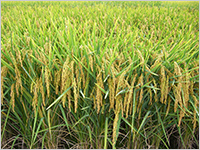Enlarge Image
Arsenic toxicity: Reducing accumulation in rice grains
Arsenic is a highly toxic element derived from both natural and human sources, the accumulation of which can trigger cancer and skin diseases in humans. A key human health concern is the contamination of drinking water and soils with arsenic, a phenomenon which is particularly prevalent in South and South-East Asia where rice is grown in contaminated water and soils. Rice plants are particularly good at absorbing arsenic, and the chemical accumulates heavily in the rice grains, subsequently transferring to the food chain.
Now, Jian Feng Ma and co-workers at Okayama University, together with scientists in Korea and Switzerland, have identified a transporter protein in rice called OsABCC1 which appears to restrict the accumulation of arsenic in rice grains, suggesting a strategy for limiting arsenic accumulation.
Ma and his team focused on phloem cells found in the plant’s nodes, where arsenic accumulates from the root system before being transferred to the grains. Through a series of experiments, the researchers found that knocking out OsABCC1 gene resulted in 13-18 times more As accumulation in the grains, indicating that this transporter played a vital role in limiting arsenic accumulation in the grains.
In this way, OsABCC1 also protects future generations of the rice plants, which can be grown from grains with lower arsenic levels. Over-expression of OsABCC1 could generate rice plants with high arsenic-tolerant and low accumulation in future.
Publication and Affiliation
Won-Yong Songa, Tomohiro Yamakib, Naoki Yamajib, Donghwi Koa, Ki-Hong Jungc, Miho Fujii-Kashinob, Gynheung Anc, Enrico Martinoiaa,b, Youngsook Leea , and Jian Feng Mab. A rice ABC transporter, OsABCC1, reduces arsenic accumulation in the grain. PNAS (online Sept 2014).
a. Division of Integrative Biosciences and Biotechnology, Pohang University of Science and Technology, Pohang 790-784, Korea;
b. Institute of Plant Science and Resources, Okayama University, Chuo 2-20-1, Kurashiki 710-0046, Japan;
c. Graduate School of Biotechnology & Crop Biotech Institute, Kyung Hee University, Yongin 446-701, Korea;
d. Institute of Plant Biology, University Zurich, 8008 Zurich, Switzerland
*corresponding author, e-mail address: maj@rib.okayama-u.ac.jp

